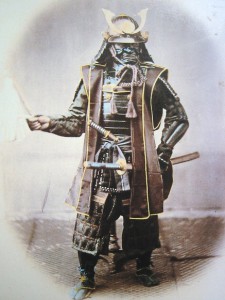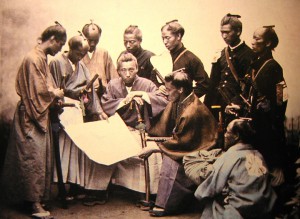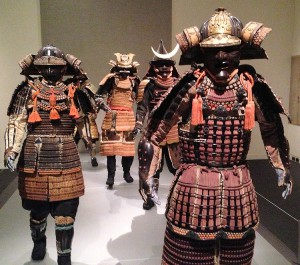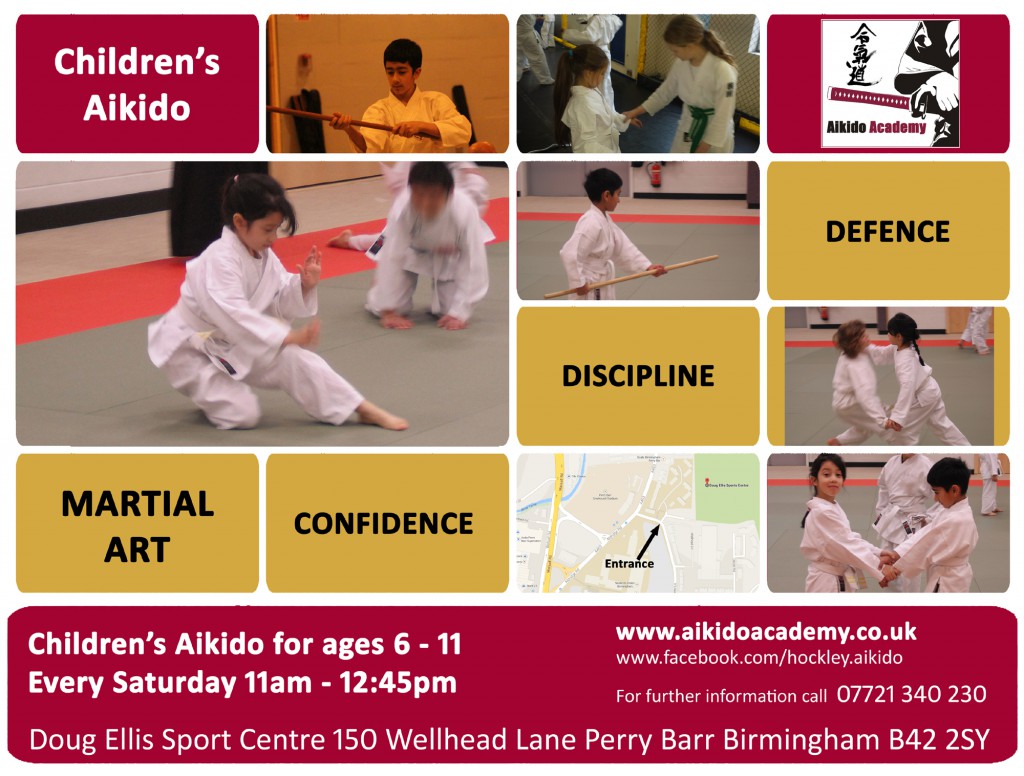Brief History of the Samurai
courtesy of Mark McGee
 Japan has a history that dates back thousands of years. Scientists believe the Japanese people descended from many groups that migrated to the islands from other parts of Asia, including China and Korea. As early as 4500 B.C., the Japanese islands were inhabited by fishermen, hunters and farmers. The early culture was known as “Jomon,” which meant “cord pattern.” That’s because the people made pottery decorated with rope-like designs. Scientists believe a caucasian race called the “Ainu” were the first inhabitants of what is now Japan. The Ainu still exist today, mostly in the northernmost islands of Japan called “Hokkaido.” The next major Japanese cultural changed occured about 200 B.C. The people were known as “Yayoi.” The Yayoi were mostly farmers. Scientists believe the present-day Japanese closely resemble the Yayoi in appearance and language.
Japan has a history that dates back thousands of years. Scientists believe the Japanese people descended from many groups that migrated to the islands from other parts of Asia, including China and Korea. As early as 4500 B.C., the Japanese islands were inhabited by fishermen, hunters and farmers. The early culture was known as “Jomon,” which meant “cord pattern.” That’s because the people made pottery decorated with rope-like designs. Scientists believe a caucasian race called the “Ainu” were the first inhabitants of what is now Japan. The Ainu still exist today, mostly in the northernmost islands of Japan called “Hokkaido.” The next major Japanese cultural changed occured about 200 B.C. The people were known as “Yayoi.” The Yayoi were mostly farmers. Scientists believe the present-day Japanese closely resemble the Yayoi in appearance and language.
War played a central part in the history of Japan. Warring clans controlled much of the country. A chief headed each clan; made up of related families. The chiefs were the ancestors of Japan’s imperial family. The wars were usually about “land.” Only 20% of the land was fit for farming. The struggle for control of that land eventually gave rise to the Samurai.
One of the important dates in the history of the Japanese warring class is 660 B.C. That’s when, according to legend, Jimmu Tenno became head of a confederation of warlike clans. Tenno was known as “The Divine Warrior.” He led his people from Kyushu to the Kinki region and conquered the people there. Tenno settled in the area of Yamato. This eventually gave rise to the Yamato dynasty and state. The leaders of Yamato believed themselves to be of divine origin.
 The Yamato clans conducted many military campaigns on the Asian mainland. The targets included Korea and China. These campaigns led to the importation of Korean and Chinese culture, technology and martial arts.
The Yamato clans conducted many military campaigns on the Asian mainland. The targets included Korea and China. These campaigns led to the importation of Korean and Chinese culture, technology and martial arts.
Legend says that Emperor Keiko was the first person with the title of “Shogun.” The word meant “Barbarian-subduing General.” Legend continues that Keiko had a son named “Prince Yamato.” He was cunning, fearless, strong and a great martial artist. Many believe that Yamato was a role model for future Samurai.
Ancient Yayoi warriors developed weapons, armour and a code during the ensuing centuries that became the centerpiece for the Japanese Samurai. Early weapons included bows, arrows and swords. Armour included a helmet that protected head and neck, a breasplate that protected the chest, arm and shoulder protectors, and a belly wrap. Later armour included protection for the legs and thighs. Armour changed as the type of battles changed. A big change occured in the 5th century when horses were introduced to Japan. Another change occured in the 15th century because of the constancy of war and the introduction of guns into battle. The code developed from the Chinese concept of the virtues of warriors doing battle to the Samurai code of chivalry known as Kyuba no michi (“The Way of Horse and Bow”) to the Bushido (“Way of the Warrior”) code.
“Bushido” means “Way of the Warrior.” It was at the heart of the beliefs and conduct of the Samurai. The philosophy of Bushido is “freedom from fear.” It meant that the Samurai transcended his fear of death. That gave him the peace and power to serve his master faithfully and loyally and die well if necessary. “Duty” is a primary philosophy of the Samurai.
The Samurai rose out of the continuing battles for land among three main clans: the Minamoto, the Fujiwara and the Taira. The Samurai eventually became a class unto themselves between the 9th and 12th centuries A.D. They were called by two names: Samurai (knights-retainers) and Bushi (warriors). Some of them were related to the ruling class. Others were hired men. They gave complete loyalty to their Daimyo (feudal landowners) and received land and position in return. Each Daimyo used his Samurai to protect his land and to expand his power and rights to more land.
 The Samurai became expert in fighting from horseback and on the ground. They practiced armed and un-armed combat. The early Samurai emphasized fighting with the bow and arrow. They used swords for close-in fighting and beheading their enemies. Battles with the Mongols in the late 13th century led to a change in the Samurai’s fighting style. They began to use their sword more and also made more use of spears and naginata. The Samurai slowly changed from fighting on horseback to fighting on foot.
The Samurai became expert in fighting from horseback and on the ground. They practiced armed and un-armed combat. The early Samurai emphasized fighting with the bow and arrow. They used swords for close-in fighting and beheading their enemies. Battles with the Mongols in the late 13th century led to a change in the Samurai’s fighting style. They began to use their sword more and also made more use of spears and naginata. The Samurai slowly changed from fighting on horseback to fighting on foot.
The Samurai wore two swords (daisho). One was long; the other short. The long sword (daito – katana) was more than 24 inches. The short sword (shoto – wakizashi) was between 12 and 24 inches. The Samurai often gave names to their swords and believed it was the “soul” of their warriorship. The oldest swords were straight and had their early design in Korea and China. The Samurai’s desire for tougher, sharper swords for battle gave rise to the curved blade we still have today. The sword had its beginning as iron combined with carbon. The swordsmith used fire, water, anvil and hammer to shape the world’s best swords. After forging the blade, the sword polisher did his work to prepare the blade for the “furniture” that surrounded it. Next, the sword tester took the new blade and cut through the bodies of corpses or condemned criminals. They started by cutting through the small bones of the body and moved up to the large bones. Test results were often recorded on the nakago (the metal piece attaching the sword blade to the handle).
Samurai Dates of Importance
- 660 B.C. — Legend says Jimmu Tenno became Japan’s first emperor and set up the ruling Yamato State. Weapons and armour develop.
- 400′s A.D. — Horses introduced into Japanese fighting.
- 500′s A.D. — Buddhism arrived in Japan; becomes a powerful philosophy for rulers and warriors.
- 500′s A.D. — Soga clan dominated the Yamato court.
- 645 A.D. — Taika Reforms began.
- 702 A.D. — Taiho law codes established the Great Council of State.
- 710 A.D. — Nara rule began with first permanent capital.
- 781 A.D. — Emperor Kammu came to power and moved capital to Kyoto a few years later.
- 794 A.D. — Heian period began.
- 858 A.D. — Fujiwara family gained control of imperial court.
- 935 A.D. — Taira Masakado revolted and proclaimed himself “The New Emperor.” Other Samurai leaders exerted their influence across the land and changed the history of Japan.
- 1180-85 A.D. — Minamoto Yoritomo takes up arms against the Taira clan in The Gempei War.
- 1192 A.D. — Yoritomo became first permanent shogun of Japan and set up his Samurai government in Kamakura.
- Late 1200′s A.D. — Mongols invade Japan. The Samurai defeat the Mongols after many years of fierce fighting. The Samurai developed a style of formation combat and depended more on the sword as a primary weapon in battle.
- 1318 A.D. — Go-Daigo became the 96th Emperor of Japan. He attempted to overthrow the Hojo regents, but gave rise instead to a new dynasty of Shoguns, the Ashikaga family, who set up their government in the capital city of Kyoto.
- 1400′a A.D. — Master swordsmen established schools to teach their style of ken-jutsu.
- 1467-77 A.D. — The Onin War saw the decline of the Shogun’s power and began the Sengoku Jidai (“The Age of the Country at War”) which lasted 150 years.
- 1542 A.D. — Portuguese guns were introduced into Japan.
- 1560 A.D. — Oda Nobunaga began the process of unifying Japan. Toyotomi Hideyoshi continued the quest after Nobunaga’s death.
- 1592 A.D. — Hideyoshi invaded Korea on his way to invading China, but died in 1598 before succeeding.
- 1603 A.D. — The Tokugawa family began ruling Japan. The regime lasted more than 200 years.
- 1605 A.D. — Miyamoto Musashi, Japan’s most famous Samurai, began his musha-shugyo (warrior pilgrimage). Musashi fought and won more than 60 sword fights before the age of 30. He founded the Individual School of Two Skies and taught for many years. At the age of 60, Musashi wrote Gorin No Sho (“The Book of Five Spheres”), the most famous writing about the Japanese Sword Arts. He also wrote “The 35 Articles on the Art of Swordsmanship.”
- 1615 A.D. — Tokugawa Ieyasu drew up the “Buke Sho Hatto” (Rules for Martial Families) before his death. It gave Samurai 13 guides to living as a warrior during peace time.
- 1630 A.D. — Japan cut its ties with the outside world.
- 1854 A.D. — Commodore Matthew Perry opened trade between the United States and Japan.
- 1867 A.D. — Emperor Mutsuhito regained his traditional powers and took the name Meiji. It was the beginning of the Meiji Restoration. Meiji (Mutsuhito) set up his new capital city in Edo (Tokyo).
- 1868 A.D. — Emperor Meiji introduced the “Five Articles Oath” which began the dismantling of the Samurai class.
- 1873 A.D. — Emperor Meiji established an army based on conscription; an army open to anyone.
- 1876 A.D. — Emperor Meiji declared a new law that ended the wearing of swords. The Samurai had lost their profession and their right to wear swords. Their position as a special class ended after almost 1,000 years.
Samurai Terms
- Batto-jutsu
- A sword-drawing art that includes cutting rolled straw targets
- Bo-jutsu
- Staff fighting
- Budo
- Martial or Fighting Arts
- Bushido
- The Way of the Warrior
- Chokuto
- Straight sword used in Japan’s early history
- Daimyo
- Feudal landowner
- Daisho
- Samurai’s two swords (one long – katana, one short – wakizashi)
- Edo Period
- 1600 – 1867 when Tokugawa government ruled Japan
- Giri
- Samurai’s duty
- Gunpai
- War fan
- Hakama
- Divided skirt-pants Samurai wore
- Heian Period
- 782 – 1184 when Japan’s capital was located in Kyoto
- Iai-jutsu
- Art of Drawing the Sword
- Kamakura Period
- 1185 – 1332 when the capital of Japan was in Kamakura. Known as the “golden age” of the Japanese sword.
- Kampaku
- Regent
- Katana
- Long sword
- Ken
- Sword – refers specifically to an ancient, two-edge sword made before the ninth century
- Ken-jutsu
- Art of the Sword
- Koto
- Swords made before the Edo Period
- Kyo-jutsu
- Bow and arror fighting
- Kyuba no michi
- The Way of the Horse and Bow
- Kyu-jutsu
- Japanese archery
- Mei
- Name of a sword
- Momoyana Period
- 1573 – 1599 when Samurai began wearing daisho. Also beginning of the Shinto (new sword) period.
- Mon
- Family crest worn on montsuki
- Montsuki
- Kimono top Japanese wore at formal occasions
- Muramasa
- Sword maker
- Muromachi Period
- 1392 – 1572 when constant civil wars greatly increased the production of swords.
- Musha-shugyo
- Warrior pilgrimage
- Naginata
- Long pole with curved blade on one end
- Naginata-jutsu
- Way of the Naginata
- Nambokucho Period
- 1333 – 1391 when two emperors were vying for power in Japan
- No-dachi
- Long sword
- Ronin
- Master-less Samurai
- Ryu
- Particular school or style of martial arts
- Samurai
- Member of the warrior class
- Sensei
- Teacher
- Seppuku
- Ritual suicide
- Shin Shinto
- “New New Sword” – any sword made after Meiji Restoration (1870)
- Shinto
- “New Sword” – any sword made between 1596 and 1870
- Shogun
- Barbarian subduing General (war lord)
- So-jutsu
- Spear fighting
- Sohei
- Warrior monks
- Tachi
- Long, deeply curved sword that mounted Samurai used in ancient Japan
- Uchigatana
- “Inside sword” – a term for the longer of two swords Samurai wore
- Wakizashi
- Short sword
- Zanshin
- Samurai’s sensing danger
Samurai Bibliography
- Harry Cook – “Samurai: The Story of a Warrior Tradition” (Sterling Publishing)
- Darrell Craig – “Iai: The Art of Drawing the Sword” (Charles Tuttle Co.)
- Donn Draeger – “The Martial Arts and Ways of Japan” (Weatherhill Inc.)
- Miyamoto Musashi – “The Book of Five Rings” (Shambhala Inc.)
- Masayuki Shimabukuro – “Flashing Steel” (Frog Ltd.)
- Nicklaus Suino – “The Art of Japanese Swordsmanship” (Weatherhill Inc.)









